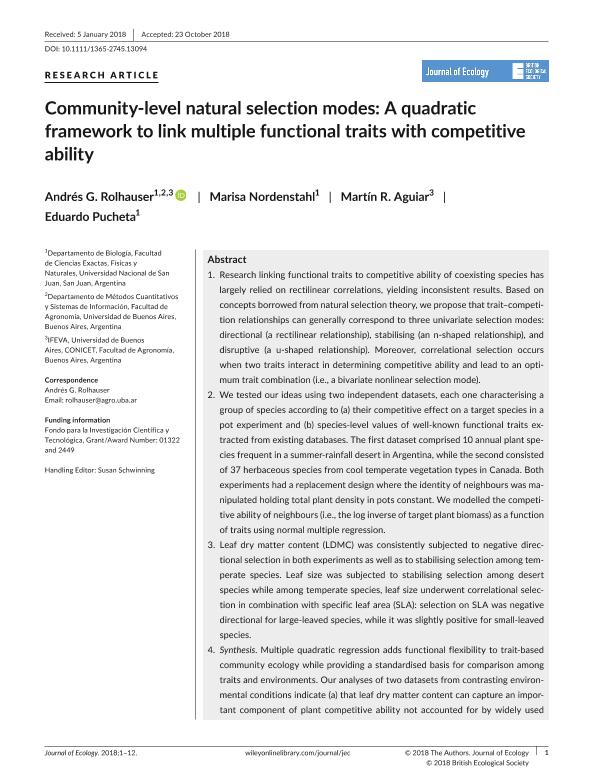Mostrar el registro sencillo del ítem
dc.contributor.author
Rolhauser, Andrés Guillermo

dc.contributor.author
Nordenstahl, Marisa

dc.contributor.author
Aguiar, Martin Roberto

dc.contributor.author
Pucheta, Eduardo Raúl

dc.date.available
2021-12-13T05:10:08Z
dc.date.issued
2018-11-05
dc.identifier.citation
Rolhauser, Andrés Guillermo; Nordenstahl, Marisa; Aguiar, Martin Roberto; Pucheta, Eduardo Raúl; Community-level natural selection modes: A quadratic framework to link multiple functional traits with competitive ability; Wiley Blackwell Publishing, Inc; Journal of Ecology; 107; 3; 5-11-2018; 1457-1468
dc.identifier.issn
0022-0477
dc.identifier.uri
http://hdl.handle.net/11336/148563
dc.description.abstract
Research linking functional traits to competitive ability of coexisting species has largely relied on rectilinear correlations, yielding inconsistent results. Based on concepts borrowed from natural selection theory, we propose that trait?competition relationships can generally correspond to three univariate selection modes: directional (a rectilinear relationship), stabilising (an n-shaped relationship), and disruptive (a u-shaped relationship). Moreover, correlational selection occurs when two traits interact in determining competitive ability and lead to an optimum trait combination (i.e., a bivariate nonlinear selection mode). We tested our ideas using two independent datasets, each one characterising a group of species according to (a) their competitive effect on a target species in a pot experiment and (b) species-level values of well-known functional traits extracted from existing databases. The first dataset comprised 10 annual plant species frequent in a summer-rainfall desert in Argentina, while the second consisted of 37 herbaceous species from cool temperate vegetation types in Canada. Both experiments had a replacement design where the identity of neighbours was manipulated holding total plant density in pots constant. We modelled the competitive ability of neighbours (i.e., the log inverse of target plant biomass) as a function of traits using normal multiple regression. Leaf dry matter content (LDMC) was consistently subjected to negative directional selection in both experiments as well as to stabilising selection among temperate species. Leaf size was subjected to stabilising selection among desert species while among temperate species, leaf size underwent correlational selection in combination with specific leaf area (SLA): selection on SLA was negative directional for large-leaved species, while it was slightly positive for small-leaved species. Synthesis. Multiple quadratic regression adds functional flexibility to trait-based community ecology while providing a standardised basis for comparison among traits and environments. Our analyses of two datasets from contrasting environmental conditions indicate (a) that leaf dry matter content can capture an important component of plant competitive ability not accounted for by widely used competitive traits, such as specific leaf area, leaf size, and plant height and (b) that optimum relationships (either univariate or bivariate) between competitive ability and plant traits may be more common than previously realised.
dc.format
application/pdf
dc.language.iso
eng
dc.publisher
Wiley Blackwell Publishing, Inc

dc.rights
info:eu-repo/semantics/openAccess
dc.rights.uri
https://creativecommons.org/licenses/by-nc-sa/2.5/ar/
dc.subject
COMMUNITY ASSEMBLY
dc.subject
COMPETITION EXPERIMENT
dc.subject
CORRELATIONAL SELECTION
dc.subject
LEAF DRY MATTER CONTENT
dc.subject
LEAF SIZE
dc.subject
PHENOTYPIC SELECTION
dc.subject
PLANT–PLANT INTERACTIONS
dc.subject
QUADRATIC REGRESSION
dc.subject
SPECIFIC LEAF AREA
dc.subject
STABILISING SELECTION
dc.subject.classification
Ecología

dc.subject.classification
Ciencias Biológicas

dc.subject.classification
CIENCIAS NATURALES Y EXACTAS

dc.title
Community-level natural selection modes: A quadratic framework to link multiple functional traits with competitive ability
dc.type
info:eu-repo/semantics/article
dc.type
info:ar-repo/semantics/artículo
dc.type
info:eu-repo/semantics/publishedVersion
dc.date.updated
2020-12-15T14:17:39Z
dc.journal.volume
107
dc.journal.number
3
dc.journal.pagination
1457-1468
dc.journal.pais
Reino Unido

dc.journal.ciudad
Londres
dc.description.fil
Fil: Rolhauser, Andrés Guillermo. Universidad Nacional de San Juan; Argentina. Consejo Nacional de Investigaciones Científicas y Técnicas. Oficina de Coordinación Administrativa Parque Centenario. Instituto de Investigaciones Fisiológicas y Ecológicas Vinculadas a la Agricultura. Universidad de Buenos Aires. Facultad de Agronomía. Instituto de Investigaciones Fisiológicas y Ecológicas Vinculadas a la Agricultura; Argentina
dc.description.fil
Fil: Nordenstahl, Marisa. Universidad Nacional de San Juan; Argentina. Consejo Nacional de Investigaciones Científicas y Técnicas; Argentina
dc.description.fil
Fil: Aguiar, Martin Roberto. Consejo Nacional de Investigaciones Científicas y Técnicas. Oficina de Coordinación Administrativa Parque Centenario. Instituto de Investigaciones Fisiológicas y Ecológicas Vinculadas a la Agricultura. Universidad de Buenos Aires. Facultad de Agronomía. Instituto de Investigaciones Fisiológicas y Ecológicas Vinculadas a la Agricultura; Argentina
dc.description.fil
Fil: Pucheta, Eduardo Raúl. Universidad Nacional de San Juan; Argentina
dc.journal.title
Journal of Ecology

dc.relation.alternativeid
info:eu-repo/semantics/altIdentifier/doi/http://dx.doi.org/10.1111/1365-2745.13094
dc.relation.alternativeid
info:eu-repo/semantics/altIdentifier/url/https://besjournals.onlinelibrary.wiley.com/doi/10.1111/1365-2745.13094
Archivos asociados
